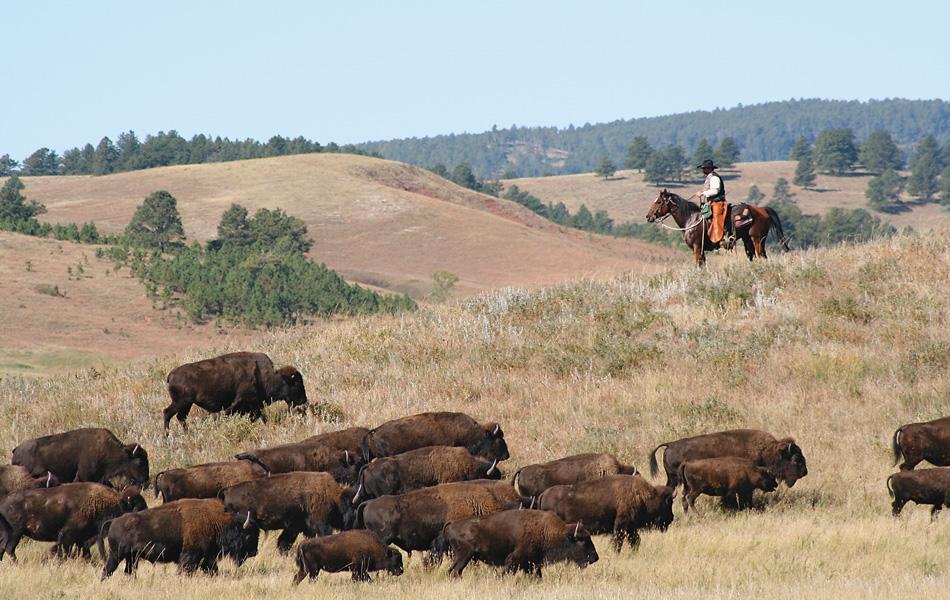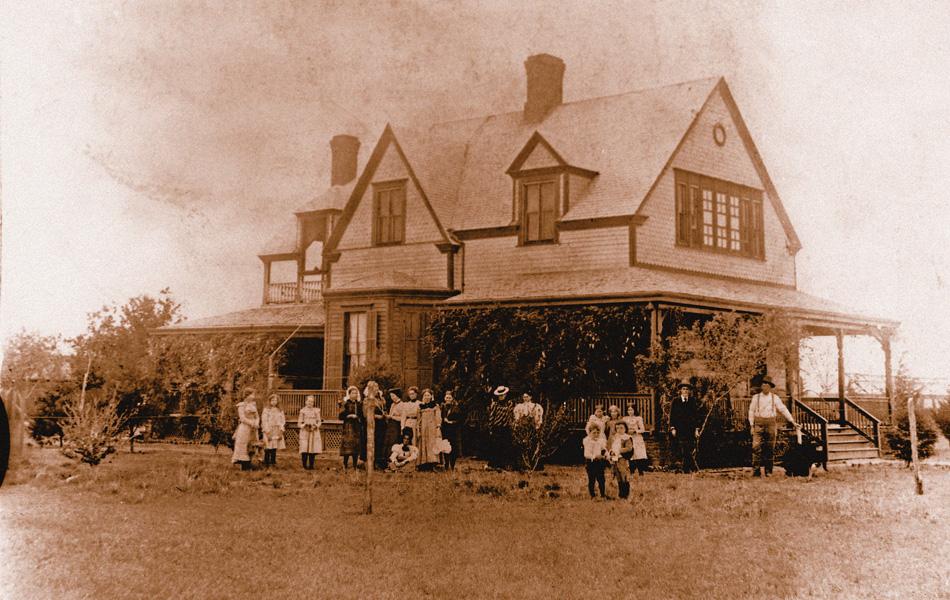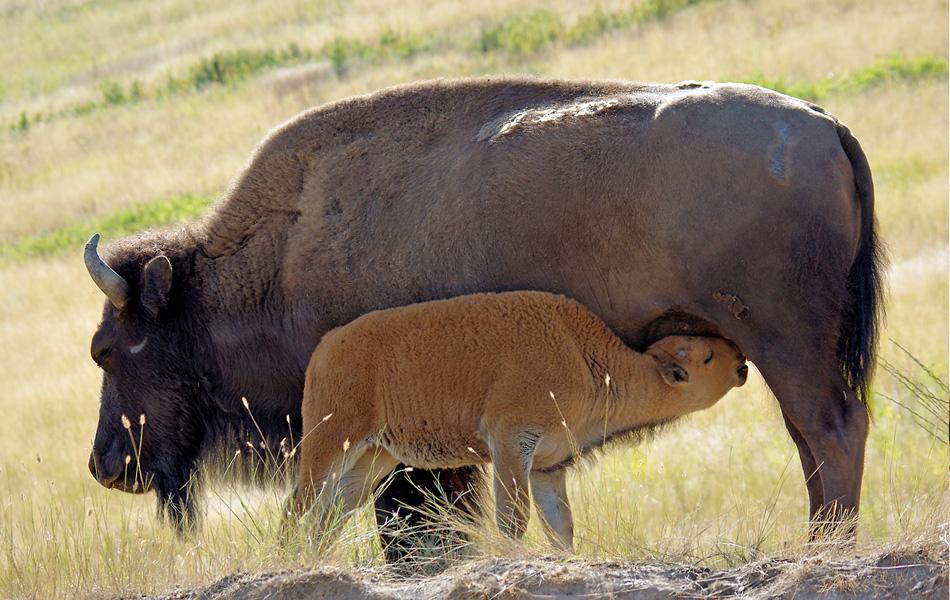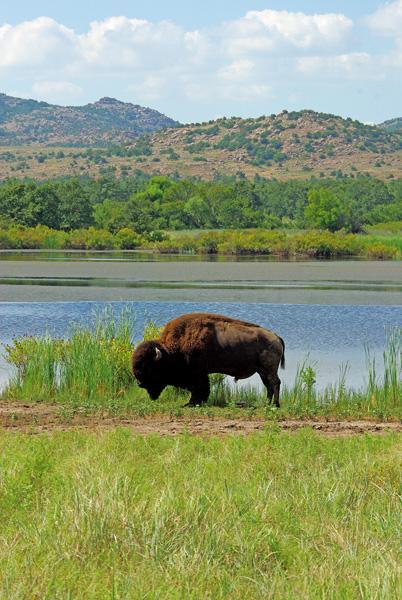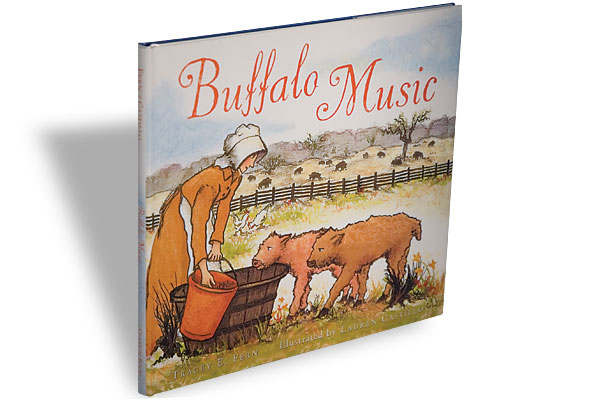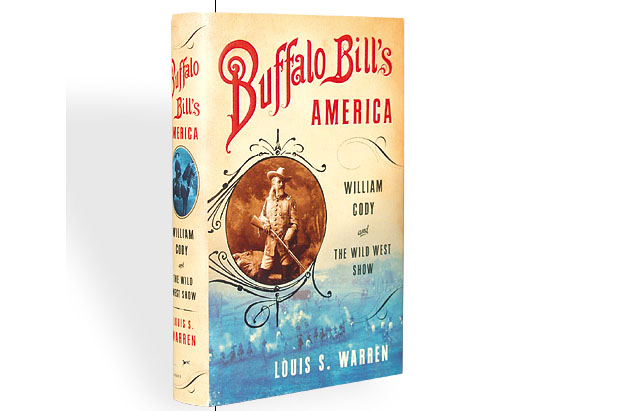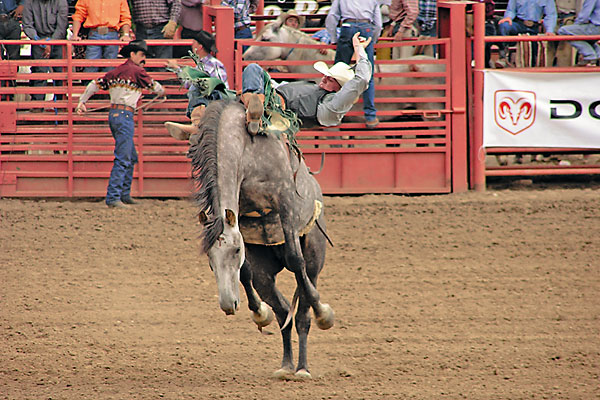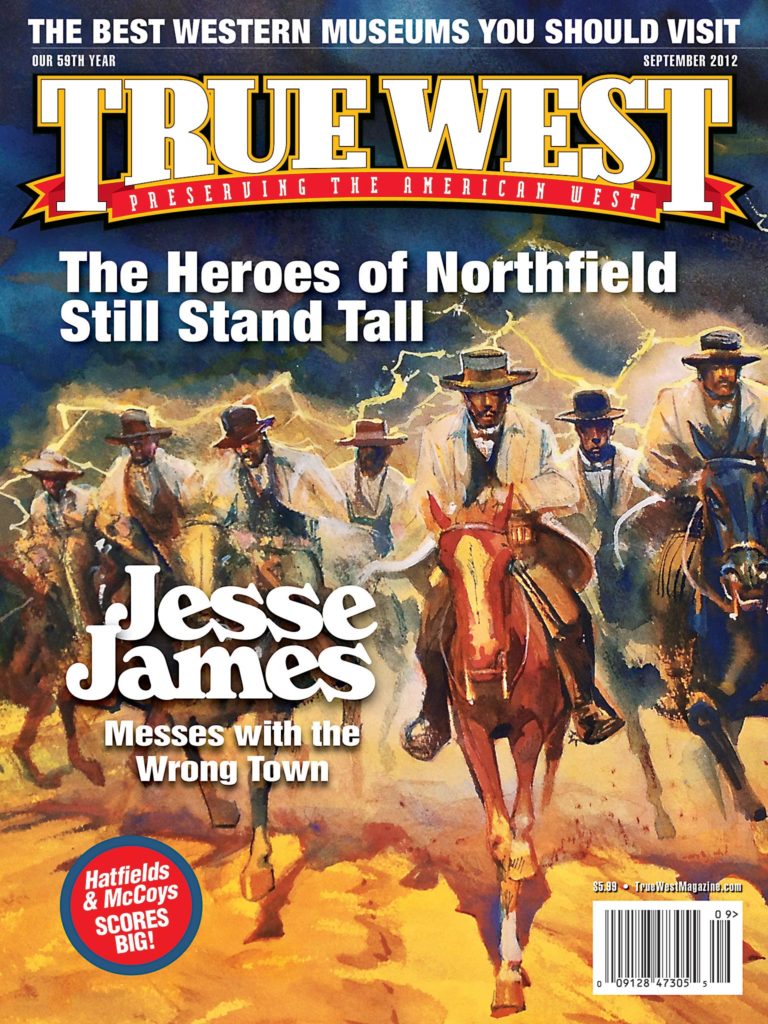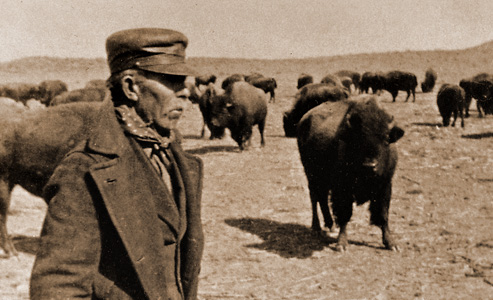 In the Rockies of Western Montana, I have the most perfect view of a buffalo. It’s inspiring, humbling, beautiful, majestic.
In the Rockies of Western Montana, I have the most perfect view of a buffalo. It’s inspiring, humbling, beautiful, majestic.
Char-grilled, eight ounces of tenderloin—cooked rare (chef Chris Kimmel will butcher guests who ask for it cooked any other way)—accented with onion straws, roasted garlic mashed potatoes and asparagus spears. The only thing missing here at Buck’s T-4 Lodge in Big Sky is a Wild Huckleberry Martini, and what luck. Here comes my waitress.
All right, all right. I’m supposed to be herding live buffalo—American bison, to be species correct—but after admiring those shaggies in seven states, I deserve a great meal.
Besides, I have already enjoyed excellent views of living buffalo, the American icon that Benjamin Franklin called a courageous animal that “would not hesitate to attack a grenadier of the British Guards who should presume to invade his farm yard with a red coat on.”
Okay, Franklin wrote those words about a turkey, not a buffalo. But who’d want to go on a Western turkey tour?
When you think about American buffalo, it’s amazing. They were key—for food, supplies and spirituality—to Indian tribes such as the Lakota, Comanche, Kiowa, Cheyenne. They were almost wiped out by white buffalo hunters.
It took a cattleman—actually, his wife—to help save them.
Big Things in Texas
In 1878, the great Southern herd, which once numbered in the tens of millions, was no more. Only a few animals had survived the slaughter for horns, meat, but mostly, hides. Cattleman Charles Goodnight’s wife, Molly, suggested he do something about that, so he started roping a few.
Ol’ Charlie and his wife were visionaries. It wasn’t until 1905 that William T. Hornaday helped organize the American Bison Society to save those shaggy-haired beasts.
Goodnight’s herd not only survived, it grew, and that proved important. He sent buffalo to zoos, to Yellowstone National Park and to other ranches. In 1997, when Goodnight’s buffalo were donated to Texas Parks and Wildlife Department, tests revealed that the DNA was different than other North American bison. That means the 80 or so buffalo you can see today at Caprock Canyons State Park & Trailway near Quitaque represent the last remaining Southern Plains buffalo.
Last year, Caprock Canyons moved the buffalo from a 300-acre pasture to more than 700 acres of native grass prairie. It’s a great place for buffalo to roam.
In Old Oklahoma
As a Comanche warrior and leader, Quanah Parker did all he could to keep the buffalo thriving, so next stop: Wichita Mountains Wildlife Refuge near Cache, Oklahoma. You remember Quanah—especially if you’ve read S.C. Gwynne’s book Empire of the Summer Moon. Quanah led the Indian assault on white hunters at Adobe Walls in the Texas Panhandle in 1874. He also helped keep the buffalo alive.
Quanah was the one who persuaded Theodore Roosevelt to establish the Wichita Mountains preserve in 1901. Six years later, 15 buffalo (six bulls and nine cows) were reintroduced here. They were Yankee buffalo—coming from the New York Zoological Park—but no Okie minded that. Quanah and others met the animals at the train station and hauled them to the Wichitas, where they multiplied like rabbits.
U.S. Fish & Wildlife officials estimate that more than 10,000 buffalo have been sold or donated to help keep the grasslands in good working order. A public auction is held the fourth Thursday of each October.
The Wichitas were sacred to the Comanche, and the presence of buffalo in the preserve today helps keep these tree-studded hills special.
Promoting Kansas
On the way to Garden City, make a detour to Dodge City. The historic town known for Wyatt Earp and Gunsmoke started off as a buffalo hunting center in the 1870s. The Boot Hill Museum offers an exhibit of buffalo, where you can hear views about bison from an Indian and a white hunter, then examine items made from buffalo, including bone china, toothbrushes and buttons.
Yet Kansans weren’t all bad guys when it came to buffalo. One did his part to save them. Next stop, Garden City.
Novelist Zane Grey immortalized Charles Jesse Jones in his novel The Last of the Plainsmen, but what “Buffalo” Jones really did wasn’t fiction.
The Illinoisan arrived in Kansas in 1866, hunting buffalo, capturing wild horses and helping found Garden City in 1879. After the disastrous hard winter of 1886 left thousands of cattle dead, Jones tried breeding hardy buffalo with cattle. He advertised his new breed as “cattalo,” but his experiment didn’t work. He next turned to taming buffalo, even training some to harness, and his herd grew until the 1890s, when, broke, he was forced to sell off his roughly 150 head.
Jones might not have had the same idea as the American Bison Society, but he did help preserve the species. That’s why the buffalo, er American Bison, is the state animal of Kansas.
Established in 1916, Garden City’s 3,760-acre Sandsage Bison Range and Wildlife Area is home to the state’s oldest, publicly-owned bison herd, who like chowing down on native tall grasses such as sand bluestem, giant sandreed and sand lovegrass. The first buffalo (one bull, two cows) arrived from the Wichita Mountains in October 1924. Other buffalo raisers helped out, including 10 head from Goodnight’s herd in 1929.
These days, the Sandsage herd is maintained at roughly 60 head, and up to 95 during the summer. The buffalo you can see while touring the range might not be related to Buffalo Jones’s herd, but at least they aren’t cattalo.
Now, you can’t chase down buffalo without mentioning William F. “Buffalo Bill” Cody, so before leaving Kansas, head on up to Oakley to see Charlie Norton’s bronze sculpture The Birthplace of a Legend.
If you believe that legend, in 1868 Cody met William Comstock near here in a buffalo-hunting contest. Cody, riding his horse Brigham and shooting a breech-loading, .50 caliber Springfield rifle, killed 69 buffalo. Comstock, riding “one of his favorite horses” and shooting a .44 caliber Henry repeater, dropped 46.
The sculpture, which depicts Cody riding Brigham and about to bring down another shaggy, was unveiled in 2004 in an effort to promote tourism in the area.
Enough bronze buffalo. Let’s see some more real ones.
Nebraska Tatanka
It’s time for me to hang my hat at Fort Robinson State Park in northwestern Nebraska’s rolling, picturesque hills.
This well-preserved U.S. Army post saw a lot of history between 1874 and 1948: the death of Crazy Horse in 1877, the Cheyenne outbreak in 1879. It oversaw the Red Cloud Indian Agency, served as a cavalry remount station, even a K-9 dog training center, POW camp in WW II and a beef research station.
It’s a great park, and home to a wonderful buffalo herd. The herd numbers around 325, making this a fitting place to view bison. Before Fort Robinson was established, the area around here was a favorite hunting spot for Indians, especially the Lakota, who ruled here from about 1810.
Oh, yeah, the buffalo they serve at the park’s restaurant? It’s from the Fort Robinson herd.
Round ’em Up in S.D.
Well, I’ve made it to Custer State Park in South Dakota’s stunning Black Hills. Some 1,300 buffalo—among the world’s largest publicly-owned herds—roam about this 71,000-acre gem.
In 1913, Gov. Peter Norbeck wanted to reintroduce many species that had been driven off by gold seekers and the like. His vision worked too. Today, lucky tourists might see not only buffalo, but also elk, bighorn sheep, mountain goats, antelope and deer.
Of course, no one guarantees you will see buffalo here. They don’t always cooperate with sightseers along 18-mile Wildlife Loop Road, but they’ll be hard to miss during the annual Buffalo Roundup in September.
Then take a side trip to Deadwood. Only instead of feeding one-armed bandits at casinos, check out the museum founded by actor Kevin Costner, Tatanka: Story of the Bison, and learn about the Lakota people’s love of buffalo.
Wild in Wyoming
Now I’m heading west, across the Northern Plains, until I reach Yellowstone National Park and its 3,000 bison.
Yellowstone and buffalo are synonymous. Since prehistoric times, wild bison have lived here. By 1902, however, poachers had reduced the park’s herd to, depending on whom you ask, between 24 and 50. So the nation’s oldest national park brought in 21. The herd grew; in 1936 the historic bison habitats along the Firehole River and Hayden Valley saw buffalo again.
They thrive here, in spite of tourists.
In amazement, I watch tourists approach 2,000-pound beasts that can reach speeds of more than 30 miles per hour. They aim their cellphone cameras as if they’re about to snap a photo of a wildflower in bloom. Apparently, they can’t read warning signs that say stay at least 25 yards away from bison. Forget grizzly bears; Buffalo injure more people in Yellowstone than any other animal in the park.
Here’s a helpful guide to buffalo watching, if you’re an idiot tourist.
• Buffalo’s tail hanging down: You and the buffalo are okay.
• Buffalo’s tail extending straight out, drooping at the end: Perturbed buffalo finds you annoying.
• Buffalo’s tail sticking straight up: Buffalo’s about to sound “Charge,” and you’re toast.
Big Sky’s Big Bison
Finally, after my carnivorous detour to Buck’s T-4 and an evening’s respite in Missoula, Montana, I arrive at the National Bison Range Wildlife Refuge near Moiese.
Established in 1908, this great facility supports between 350 and 500 buffalo. The Red Sleep Mountain Drive, weather permitting, provides many great views along a 19-mile narrow road that climbs 2,000 feet in elevation. I take it slow. I have to. There’s a buffalo walking ahead of my SUV, and he’s certainly not setting any speed records. I’m not about to tailgate him or honk my horn.
If you don’t have that much time, the five-mile Prairie Drive/West Loop is open year-round and crosses the flats. Count on a half hour for that shorter tour.
As I head back to Missoula, I remember Black Elk, the Lakota holy man who told John G. Neihardt: “That fall [1883], they say, the last of the bison herds was slaughtered by the Wasichus.”
I’m glad he was misinformed.
Johnny D. Boggs recommends A Buffalo in the House by R.D. Rosen, The Buffalo Runners by Fred Grove and The Last Hunt, directed by Richard Brooks.
Photo Gallery
– All photos by Johnny D. Boggs unless otherwise noted –


